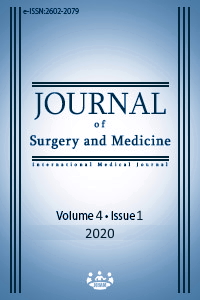Increased post-voiding residue and recurrent acute epididymitis: Are they causally related?
Keywords:
Epididymitis, Post-voiding residueAbstract
Aim: It is known that recurrent urinary tract infection (rUTI) is associated with increased post-voiding residue (PVR), however, the same relationship is yet to be shown in adults for recurrent acute epididymitis. To the best of our knowledge, there are inadequate studies on this subject and they are mainly focused on the retrograde flow of the infected urine into the ejaculatory duct in terms of pathophysiology. In this study, we aimed to evaluate the causal relationship between recurrent acute epididymitis and increased post-voiding residue.
Methods: In this retrospective cohort study, the data of 388 patients who received treatment for epididymitis in our polyclinic between 2015 and 2018 were evaluated to determine that 72 were examined for lower urinary tract symptoms (LUTS). Age, PSA level, Qmax value, uroflowmetric pattern, post-voiding residual volume, International Prostate Symptom Scores (IPSS), and prostate volumes were recorded. Patients were divided into acute (n=38, Group 1) and recurrent acute (n=34, Group 2) epididymitis groups for analysis. The patients in Group 2 were treated for epididymitis at least two times in the last six months or thrice a year. The patients in Group 1 were treated only once in a year. Chi-square (Fisher’s exact test) and Student’s t-test were used to compare categorical variables. A value of P<0.05 was considered the threshold of statistical significance.
Results: Age, PSA level, prostate volume, IPSS score, and peak flow did not significantly differ between the two groups. However, there were significant differences in terms of post-voiding residual urine volumes (P=0.029). The mean post-voiding residual volumes in patients with acute and recurrent acute epididymitis were 47.3 (16.2) ml and 178.2 (23.6) ml, respectively.
Conclusion: There is a relationship between increased post-voiding residual urine volume and recurrent acute epididymitis. Patients who present with recurrent acute epididymitis should be scanned for urological pathologies which may cause increased PVR.
Downloads
References
Cek M, Sturdza L, Pilatz A. Acute and chronic epididymitis. Eur Urol Suppl. 2017;16:124–31.
Tracy CR, Steers WD, Costabile R. Diagnosis and management of epididymitis. Urol Clin North Am. 2008;35:101–8.
Trojian TH, Lishnak TS, Heiman D. Epididymitis and orchitis: an overview. Am Fam Physician. 2009;79:583–7.
Harnisch JP, Berger RE, Alexander ER, Monda G, Holmes KK. Aetiology of acute epididymitis. Lancet. 1977 Apr 16;1(8016):819-21.
Street E, Joyce A, Wilson J. Clinical Effectiveness Group, British Association for Sexual Health and HIV. BASHH UK guideline for the management of epididymo-orchitis. 2010. Int J STD AIDS. 2011 Jul;22(7):361-5.
Nicholson A, Rait G, Murray-Thomas T, Hughes G, Mercer CH, Cassell J. Management of epididymo-orchitis in primary care results from a large UK primary care database. Br J Gen Pract. 2010 Oct;60(579):e407-22.
Weingartner K, Gerharz EW, Gillich M, Riedmiller H. Ectopic third ureter causing recurrent acute epididymitis. Br J Urol. 1998;81:164-5.
Siegel A, Snyder H, Duckett JW. Epididymitis in infants and boys: Underlying urogenital anomalies and efficacy of imaging modalities. J Urol. 1987;138:1100-3.
Kajbafzadeh AM, Shirazi M, Dianat S, Mehdizadeh M. Management of recurrent epididymitis in children: Application of neurovascular sparing vas clipping in refractory cases. J Ped Urol. 2011. Oct;7(5):552-8.
Madani A, Rahimzadeh N, Esfahani ST, Ataei N, Mohseny P, Kajbafzadeh A, et al. Posterior urethral valve in a child presenting as recurrent epididymo-orchitis. Arch Iran Med. 2008 Nov;11(6):662-4.
Banyra O, Shulyak A. Acute epididymo-orchitis: staging and treatment. Cent European J Urol. 2012;65(3):139-43.
Luzzi GA, O'Brien TS. Acute epididymitis. BJU Int. 2001 May;87(8):747-55.
Dason S, Dason JT, Kapoor A. Guidelines for the diagnosis and management of recurrent urinary tract infection in women. Can Urol Assoc J. 2011 Oct;5(5):316-22.
Al-Badr A, Al-Shaikh G. Recurrent Urinary Tract Infections. Sultan Qaboos Univ Med J. 2013 Aug;13(3).
Mittemeyer BT, Lennox KW, Borski AA: Epididymitis: a review of 610 cases. J Urol 1966;95:390-2.
Höppner W, Strohmeyer T, Hartmann M, Lopez-Gamarra D, Dreikorn K. Surgical treatment of acute epididymitis and its underlying diseases. Eur Urol. 1992;22(3):218-21.
Noguchi N, Chan L, Cumming RG, Blyth FM, Handelsman DJ, Waite LM, et al. Natural history of post-void residual urine volume over 5 years in community-dwelling older men: The Concord Health and Ageing in Men Project. Neurourol Urodyn. 2018 Mar;37(3):1068-73.
Bergamin PA, Kiosoglous AJ. Non-surgical management of recurrent urinary tract infections in women. Transl Androl Urol. 2017;6(Suppl 2):S142-S152.
José Carlos I. Truzzi, Flávio Mistreta R. Almeida, Eduardo Capati Nunes, Marcus V. Sadi. Residual Urinary Volume and Urinary Tract Infection—When are They Linked? J Urol. 2008 Jul;180(1):182-5.
O'Grady F, Mackintosh IP, Greenwood D, Watson BW. Treatment of 'bacterial cystitis' in fully automatic mechanical modelsstimulating the conditions of bacterial growth in the urinary bladder. Br J Exp Pathol.1973;54:283-90.
Özlülerden Y, Toktaş C, Zümrütbaş AE, Gülten MC, Başer A, Yapıcı O, et al. Can feeling of incomplete bladder emptying reflect significant postvoid residual urine? Is it reliable as a symptom solely? Investig Clin Urol. 2018 Jan;59(1):38-43.
Caron F, Alexandre K, Pestel-Caron M, Chassagne P, Grise P, Etienne M. Highbacterial titers in urine are predictive of abnormal postvoid residual urine in patients with urinary tract infection. Diagn Microbiol Infect Dis. 2015;83(1):63-7.
Dray E, Cameron AP, Clemens JQ, Qin Y, Covalschi D, Stoffel J. Does Post-Void Residual Volume Predict Worsening Urologic Symptoms in Patients with Multiple Sclerosis? J Urol. 2018 Oct;200(4):868-74.
Sharma A, Garg G, Pandey S, Agarwal S, Sankhwar SN. Post Circumcision Meatal Stenosis Causing Renal Failure: A Preventable and Disastrous Complication. JOJ Case Stud. 2018;7(2):555708.
Downloads
- 867 1583
Published
Issue
Section
How to Cite
License
Copyright (c) 2020 Adem Sancı, Evren Suer
This work is licensed under a Creative Commons Attribution-NonCommercial-NoDerivatives 4.0 International License.
















